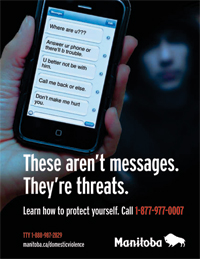
SAFETY ALERT: If you are in danger, please use a computer in a safe place, or call 911. You can leave this site quickly by clicking on Quick Escape (note: this does not clear your browser history).
Note: If you have experienced family violence and are using a computer that is shared with your abuser, use extreme caution to clear your browser history when you are finished visiting this site. If you do not know how to clear your browser, search the help available for your particular browser or use a public computer if possible.
If you are in an abusive relationship, or you know someone who may be, call 1-877-977-0007 or text 204-792-5302 or 204-805-6682.
If you are in immediate danger, call 911.
Cyber Stalking
 When one person, or group, uses technology (especially the Internet) to harass, intimidate or frighten you, it is called “cyber stalking.” It may include:
When one person, or group, uses technology (especially the Internet) to harass, intimidate or frighten you, it is called “cyber stalking.” It may include:
- keeping track of your phone conversations and Internet use
- making threats
- accusing you of things you didn’t do
- stealing your identity (by using your personal or bank information)
- damaging your personal data or equipment (ex: viruses)
- soliciting minors for sex and other aggressive behaviours
Manitoba Justice has information on cyber stalking in the Stalking is a Crime booklet
There are ways to protect yourself when using the Internet. However, if you think someone is watching your Internet use, go to an outside location to connect to it (ex: a friend’s house, library, Internet café, workplace).
Other ways to use the Internet safely:
- Protect your e-identity by using different user IDs and passwords for different accounts. If possible, do NOT write these down.
- Make the passwords more complicated by combining letters and numbers. Change your passwords regularly (ex: weekly, monthly).
- Be careful when giving out personal information (ex: name, address, phone number) or financial information (ex: bank account or credit card numbers) on the Internet.
If someone is harassing or intimidating you using Internet, cell phone or other technology:
- Save and document everything.
- Write down the time, date and place of each contact. (Even if you’re unsure about calling the police, keep written information about all the incidents.)
- If you get harassing or threatening messages by e-mail, do not delete them. Save them and print off a copy of each message for your records. If you make a report to the police, or apply for an emergency protection order, they can be used as evidence.
- If you think the person stalking you may have access to your e-mail, start another private account. Make sure your user name contains no personal information that can identify you (ex: name, address, phone number, nickname, pet’s name). And make sure you use a secure password.
- Save all threatening or harassing text messages or voice messages you receive on your cell phone (shows evidence of stalking).
- Be careful about how much personal information you include on social networking sites like Facebook or Twitter.
For more information on how to protect yourself from cyber stalking, see the resources listed below:
Link to other sites:
- www.texted.ca/app/en/ for youth and facts about texting
- www.thedoorthatsnotlocked.ca operated by Canadian Centre for Child Protection including sections for parents, teachers


